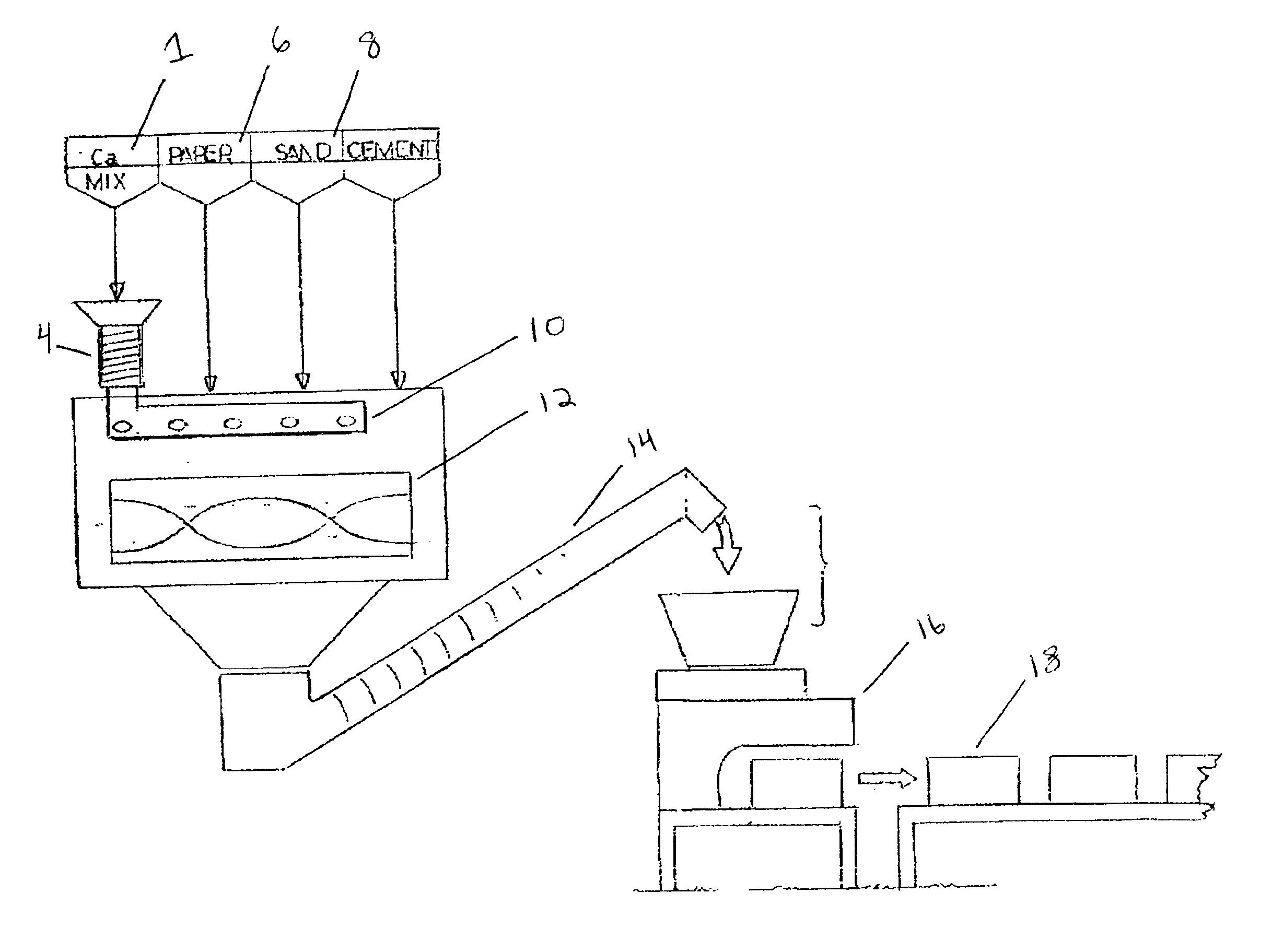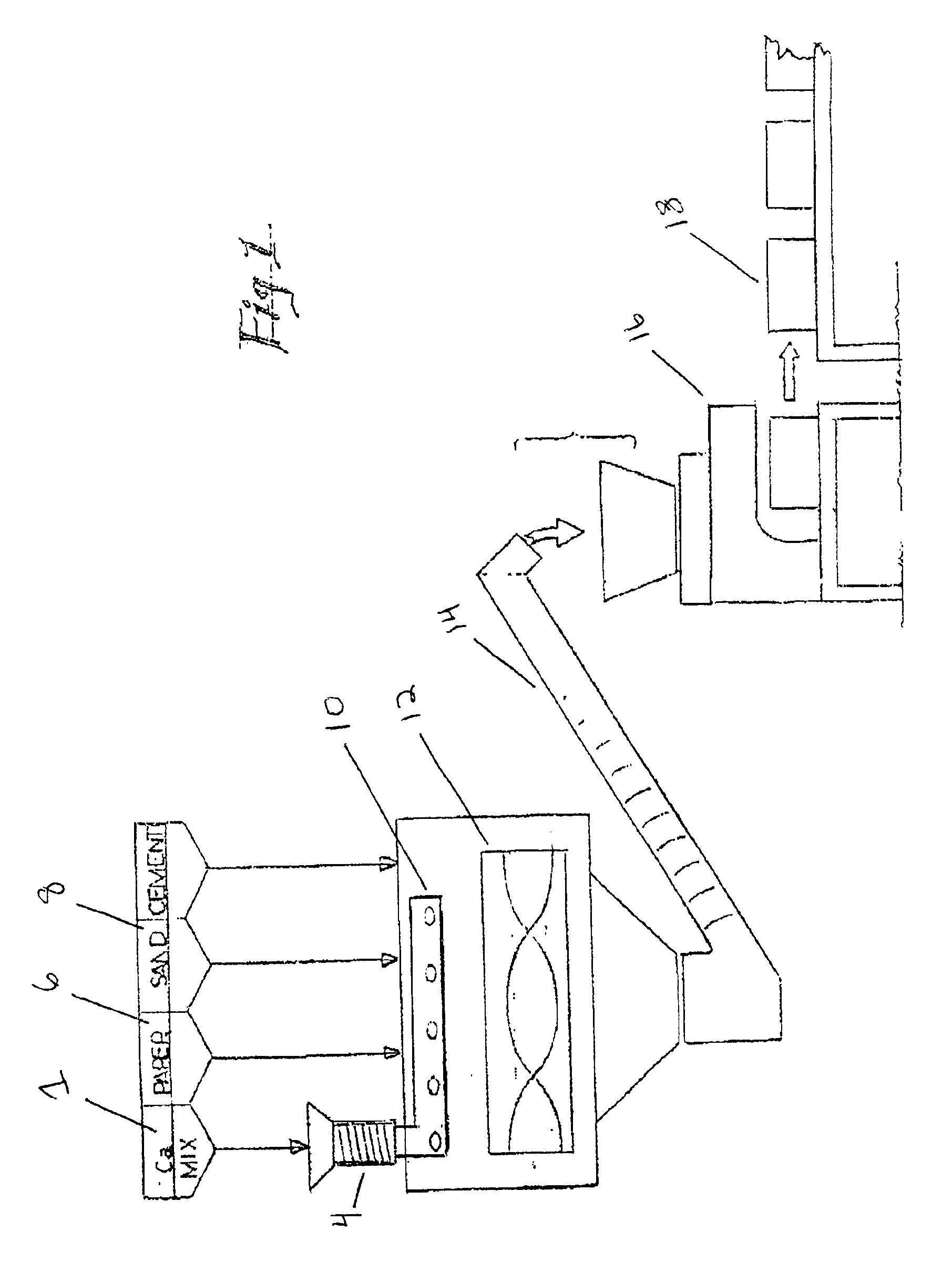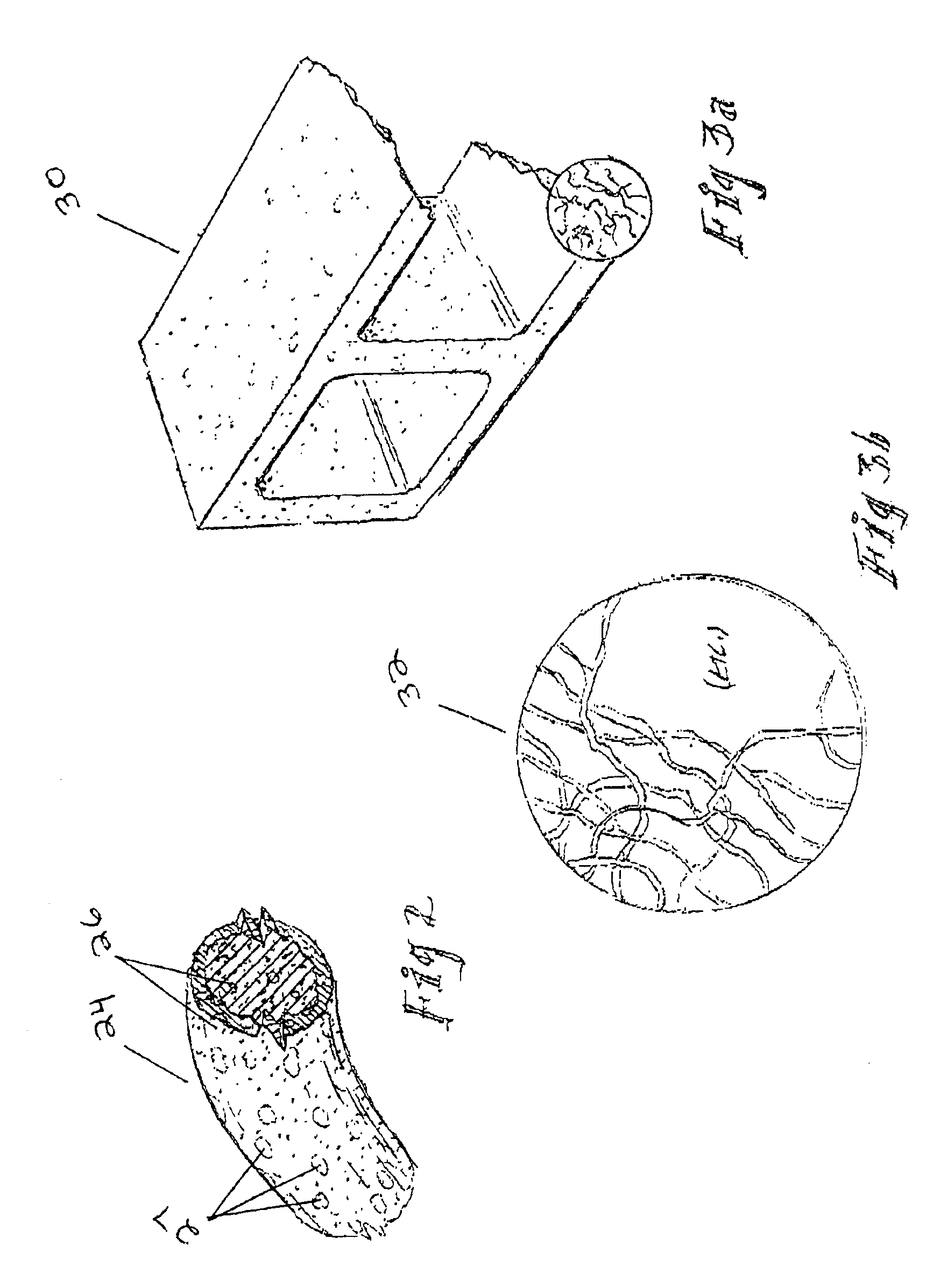Now in accordance with the present invention, a method and process of forming a lightweight cellulose modified aggregate cement is disclosed wherein dry pulp fiber is effectively and efficiently saturated with a fortifying solution demonstrating a
water content sufficient to provide said saturation and to
hydrate cement added to said mixture so as to yield a moldable material suitable for use in the formation of molded construction components. The method and process of the present invention provides such an aggregate material without need for the extraction of
excess water or the vital fortifying agents therein or the need to provide additional water to said mixture, after an initial cure, in order to
hydrate same.
The mixture is used, in a similar manner to other fortifying mixtures, to fortify the fiber content of the mix to masonry quality. Plaster of Paris may be added al approximately ten weight percent, based on the
dry weight of the mixture, in order to help minimize shrinkage. In addition,
fly ash may be added to the mix in order to produce a more lightweight final aggregate product. These fortifying components are added to the pre-mixture as an admixture. Stirring of the fortifying solution for a period of 4 to 5 minutes, produces a milk-like consistency.
The dry, purified and comminuted
cellulose fiber is treated in a fortifying solution comprised of, for example,
calcium oxide,
calcium chloride, fly ash, water proof sealer,
calcium sulfate, calcium silicates, silica oxides and aluminum
oxide.
Calcium chloride and
calcium hydroxide may also be advantageously selected as components of the fortifying solution. These components are well known to the art and may be configured and formulated in order to obtain desired properties. For example, by increasing the weight percentage of fly ash, one can produce a more light-weight final concrete product. Increasing calcium
chloride or calcium hydroxides allows these activators to speed up the cure of the aggregate.
The present invention applies, as discussed in detail below, fortifying solution to dry cellulose fibers so as to ensure complete absorption of the vital components thereof into the fiber. The fortifying solution is initially mixed for a
sufficient time so as to allow a substantially complete and uniform mixture. Thereafter, the solution is applied to dry cellulose fibers and mixed therewith for a time period long enough to ensure that the solution has achieved maximum penetration of the fiber. After sufficient mixing has been accomplished, cement, or a mixture of cement and sand is added, in a controlled fashion to the treated fiber so as to coat each fiber with cement. The water remaining in the mixture and available to the cement, is sufficient to
hydrate and form a pliable cement mixture. However, by admixing cement to pre-treated fiber, the resulting concrete mix does not include
excess water which, in the prior art, would require mechanical or other forms of extraction. The resulting concrete mix, comprised of individual cellulose fibers substantially saturated with fortifying components and coated with hydrated cemented, is easily poured into press molds for the production of desired construction forms. The material may be held in the mold for as long as is necessary for shaping. This may be as brief as three seconds or longer. The material is then heated, for example in a
kiln, for a period of about 12 hours at approximately 100 degrees Fahrenheit to yield a finished, fully cured aggregate concrete building form. In certain embodiments, cement in combination with sand is admixed to the treated fiber solution where the final product such as, for example, construction blocks, require sand as a
structural element.
In an alternate embodiment of the present Invention, a process and method for producing raw cellulose modified aggregate, while, at the same time allowing the reclaiming of submerged land, is disclosed. In practicing the alternate process of the present invention, raw cellulose
waste material, such as, for example, natural surrounding and aquatic
vegetation, industrial paper waste, recycled paper or other paper materials is added to and used to fill a natural
pool or lake. The material is allowed to soak for a
sufficient time to absorb maximum water and then pushed into a
pile and allowed to sun-dry. After sun-
drying, the material is treated with an antimold agents such as, for example,
ammonia sulfate. Thereafter, the material is once again dried. The dried and anti-mold treated waste material is then processed within a grinder wherein impurities such as, for example,
plastic materials are removed and the material is comminuted into cellulose fibers. A depression is then formed in the ground and lined with a chemically resistant liner. The depression is then filled with a fortifying solution comprised of fortifying agents such as those discussed above to form a fortifying
pool. However, the fortifying solution does not contain activating agents or water proof admix components as such would, as described below, tend to cause the curing of material prematurely so as to block and clog conduits and pipes. After the
cellulose fiber has been sufficiently treated with the fortifying solution, it is once again sun-dried. Thereafter, it is transported to a hopper from which a low pressure pump transports the material through a
feed line to a
high pressure pump. The
high pressure pump pressurizes the material so that when a catalyst pump, just downstream from the
high pressure pump adds activating agents and water seal admix components, the solution-treated fiber is placed in a highly pressurized state. Therefore, all of the fortifying agents, including the activating and water proofing agents added thereafter, are forced into the cellulose fibers for complete absorption within a mix tube leading from the high pressure pump to a processor / grinder. Within the mix tube, a
heating element is utilized to raise the temperature of the treated cellulose aggregate mixture to about 120 degrees Fahrenheit. The aggregate exiting the mix tube is a cellulose modified aggregate which is ground up within the processor. Thereafter, a rake is utilized to eliminate clumps. The resulting raw aggregate is extremely lightweight and thus economical to transport to the site of use where it may be mixed with water, cement, and in some instances sand, for the production of a cellulose modified aggregate cement.
 Login to View More
Login to View More 


